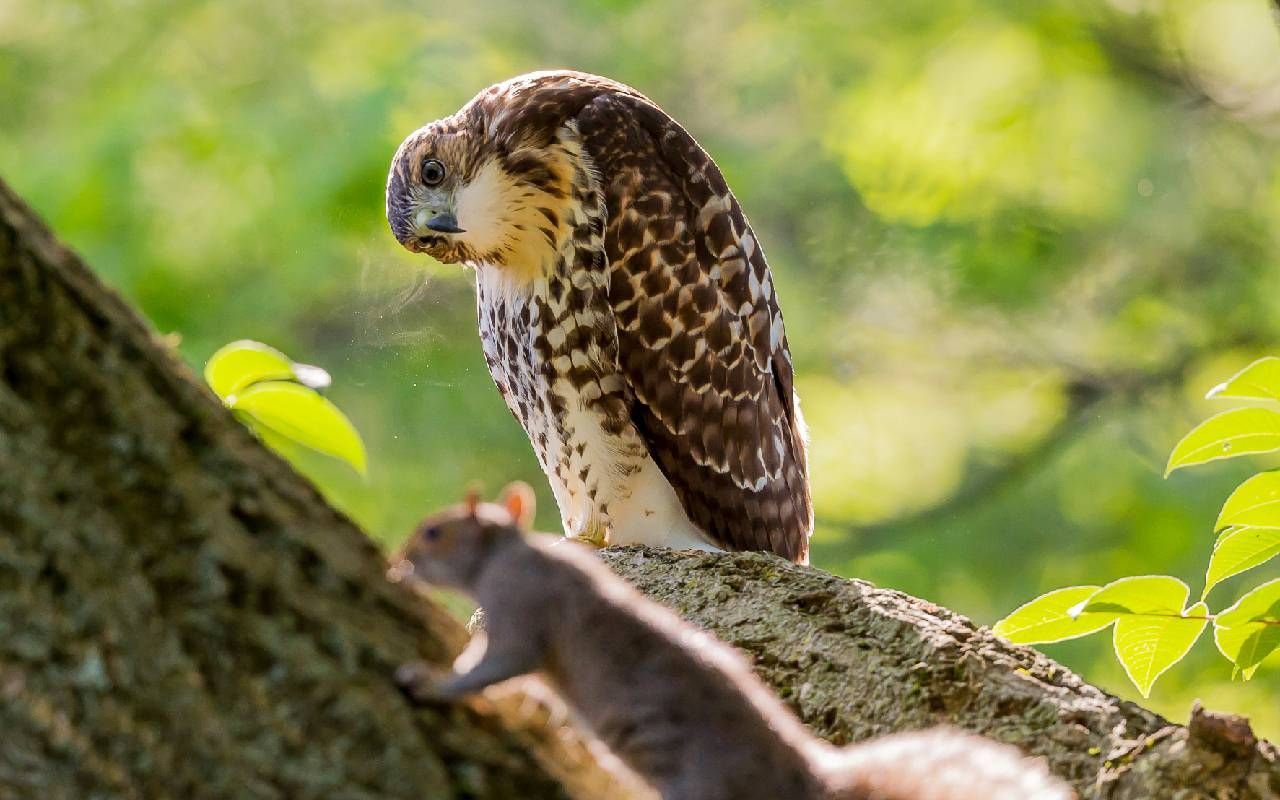The Brain Benefits of Trying Something New
Trying new tasks requires activation of less-used areas of the brain and stimulates new connections between brain regions.
Call me a reluctant bird watcher. So reticent that when my friend Pat from tennis asked if I wanted to go on a hawk watch with her, I wanted to say, "I'm from New York, I don't watch birds," or better yet, "The only birds I've watched are the pigeons in Central Park." Or how about, "I'm from New Yawk and I don't do hawks."

But Pat is a relatively new friend made at tennis in my 60s; knowing how hard it is to make friends as an adult, wanting to treat the relationship with TLC, and liking the different adventures such as easy hikes we have been on, I said yes.
"It is better to go hawk watching earlier. Would you like to stay at tennis, and we'll get together another time?"
It was late September — a perfect time to do it — according to Pat and the Massachusetts Audubon Society, which says, "September is usually the best month for fall hawk watching. Thousands of hawks that breed north of Massachusetts, along with the young of the year, move through Massachusetts in significant concentrations every fall."
I was loathe to leave a tennis clinic at the Holyoke (Massachusetts) Canoe Club, along the banks of the Connecticut River. By text, I bargained with Pat for an extra 15 minutes — a departure time of 11:15 — due to a late start at the group lesson. She texted, "It is better to go hawk watching earlier. Would you like to stay at tennis, and we'll get together another time?"
Happy to Be There
No, I wanted to go. And I was glad that we went as soon as we got out of the car in the hill town of Granville, at a spot called Blueberry Hill, which hikers love. It was an easy hike up a trail of a little more than a quarter of a mile through blueberry bushes, white pine and red oak trees and past an old shack where the owners of a family blueberry farm had sorted and washed blueberries.
I must have looked comical while trying to balance them on my eyeglass frame, but self-consciousness took a back seat to concentration.
We stopped at a rock ledge that offered a view of near and far ranges and miniature-looking towns across five states. Pat had brought binoculars for me. I must have looked comical while trying to balance them on my eyeglass frame, but self-consciousness took a back seat to concentration.
I saw something gliding high up, a paintbrush stroke, but what was it? Then others, and birdsong in the bushes behind us. Some friendly birders explained how they were logging in the birds they had seen with a local registry.
Pat later texted this report: "We saw 2 sharp-shinned hawks, Cooper's hawk, an eagle and a group of broad-winged hawks high up. We heard ravens and red-shouldered hawks. We saw blue jays and Monarch butterflies."
It was a breath of fresh air, literally and figuratively. My mind didn't have space for any of the usual worries. I later learned that birdwatching has mental health benefits and that trying new things, in general, is one key to healthy aging.
A Boost of Dopamine
"It's an antidepressant," says Dennis Buttimer, a mindfulness expert and executive coach who runs the Atlanta Center for Mindfulness and Well-Being. "When you are learning something new, you are going to boost the dopamine in your brain."
William T. Hu, MD, a neurologist and Rutgers University associate professor who studies aging, concurs. "Research shows that as you age, the brain gets lazy. But lifelong learning will increase your cognitive reserve." He says a review in the journal Neuroscience and Behavioral Reviews explains why novelty can enhance the production of dopamine, the feel-good neurotransmitter.
I later learned that birdwatching has mental health benefits and that trying new things, in general, is one key to healthy aging.
According to the paper, "Dopamine in one part of the brain enhances another part's ability to store new information and form new memories. This circuit appears to not work as well in older people as in younger people, and proactively participating in new activities and exploring new environments can potentially make this circuit stronger."
Argyle Elizabeth Hillis, MD, director of the cerebrovascular division in the Department of Neurology at Johns Hopkins Medicine, puts it this way: "Sometimes we can accomplish familiar tasks using very well-established 'motor memory' or networks that have not been affected by aging," she explains in an email.
"But trying new tasks requires activation of less-used areas of the brain and stimulates new connections between brain regions. Using all networks in the brain helps maintain adequate blood flow to areas that support those networks and prevents atrophy to those areas."
Something New: Sculpture
At least I knew what a hawk was, but I was clueless when I tried my second new thing in one year, also on the recommendation of a tennis friend. It was a two-day workshop in which I would learn to make a kind of sculpture called a stabile, and it was at Snow Farm, a residential crafts school in Williamsburg, Massachusetts at the foot of the Berkshires.
My mother was an artist and jewelry designer, but I felt the talent missed me. Still, I was ready for something new in the second pandemic spring. The Encyclopedia Britannica explains that a stabile is "a type of stationary abstract sculpture, developed by the 20th century American artist Alexander Calder and usually characterized by simple forms executed in sheet metal."
A contemporary artist who makes them says on her website that a stabile "is a free-standing kinetic mobile on a flat surface. No need to hang it; you simply display it and enjoy."
The course description at Snow Farm promised that we would make "a kinetic sculpture that will move gracefully with the air currents in your home." We would use woodworking skills and "learn the basics of constructing balancing art by shaping and assembling wire and natural mica sheets into moving elements."
It would be taught by David Winigrad, a Philadelphia-based artist whose work grew out of a fascination with "the simple, whimsical motion of whirligigs" and an inspiration "to bring a more contemporary and modern aesthetic to this form of folk art," according to his artist's statement.
I loosened up when we began sketching our ideas on a big sheet of paper, just as I did when I reached the top of the hawk-watching hill.
Over at the Snow Farm woodworking studio, when each of us in the group of six women introduced ourselves, I realized that I was the only one without an arts or crafts background. When my turn came, I said I was a writer — an artist of a different kind — interested in using another part of my brain.
They all jumped right in when it came time to get started. I was at a loss. "Look up moving art," the instructor told me. This led to a history of kinetic art — art that moves — and to Calder, one of its premiere practitioners.
I also liked Winigrad's pieces, particularly one with holes bored into the tower. I got inspired. I loosened up when we began sketching our ideas on a big sheet of paper, just as I did when I reached the top of the hawk-watching hill. My drawing wasn't too bad. But it looked better after he came over and modified the sketch so that the arms would balance. (Later, they would move at the flick of a finger).
Winograd had brought pieces of hardwood that he cut into various lengths; mine was nine inches tall. I sanded it and stained it and did the same with a base. I drilled (with help) three holes into the tower because I liked the look of one of his sculptures that he had brought, along with many colored marbles, large and small, for us to work with. We were kids playing with marbles!
The orbs would go on the ends of wires of different lengths. I picked out marbles in shades of blue and purple and two flat gold circles to add interest. It was good to have such a singular focus for those two days. And when it was done, I was pleasantly surprised. It didn't fall apart on the 45-minute ride home.
The grandkids like to give the arms a flick. The gold circles and family photographs catch the sunlight from where the stabile stands on a table. It's not museum quality, but there would still be good news even if it were the worst thing ever.
Hillis explains: "Just engaging in a new task, even if you do not accomplish it well, stimulates more areas and networks of the brain, which can prevent or delay neurodegeneration associated with aging," she wrote. "Any 'effort' (getting better at familiar tasks, or just trying unfamiliar ones) can be helpful."


